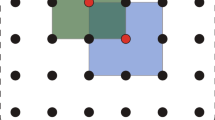Abstract
The meshless local Petrov–Galerkin method is used to analyze transient heat conduction in 3-D axisymmetric solids with continuously inhomogeneous and anisotropic material properties. A 3-D axisymmetric body is created by rotation of a cross section around an axis of symmetry. Axial symmetry of geometry and boundary conditions reduces the original 3-D boundary value problem into a 2-D problem. The cross section is covered by small circular subdomains surrounding nodes randomly spread over the analyzed domain. A unit step function is chosen as test function, in order to derive local integral equations on the boundaries of the chosen subdomains, called local boundary integral equations. These integral formulations are either based on the Laplace transform technique or the time difference approach. The local integral equations are nonsingular and take a very simple form, despite of inhomogeneous and anisotropic material behavior across the analyzed structure. Spatial variation of the temperature and heat flux (or of their Laplace transforms) at discrete time instants are approximated on the local boundary and in the interior of the subdomain by means of the moving least-squares method. The Stehfest algorithm is applied for the numerical Laplace inversion, in order to retrieve the time-dependent solutions.
Similar content being viewed by others
References
Abramowitz M, Stegun IA (1964) Handbook of mathematical functions. Applied mathematics series. Dover Publications, New York
Atluri SN (2004) The meshless method, (MLPG) for domain& BIE discretizations. Tech Science Press, Los Angeles, p 680
Atluri SN, Shen S (2002) The meshless local Petrov-Galerkin (MLPG) method. Tech Science Press, Los Angeles, p 440
Belytschko T, Krongauz Y, Organ D, Fleming M, Krysl P (1996) Meshless methods: an overview and recent developments. Comp Meth Appl Mech Eng 139:3–47
Brebbia CA, Telles JCF, Wrobel LC (1984) Boundary element techniques. Springer, Berlin Heidelberg New York
Butterfield R (1978) An application of the boundary element method to potential flow problems in generally inhomogeneous bodies. In: Brebbia CA (eds) Recent advances in boundary element method. Pentech Press, London
Carslaw HS, Jaeger JC (1959) Conduction of heat in solids. Clarendon Press, Oxford
Curran DA, Cross M, Lewis BA (1980) Solution of parabolic differential equations by the boundary element method using discretization in time. Appl Math Model 4:398–400
Davies B, Martin B (1979) Numerical inversion of the Laplace transform: a survey and comparison of methods. J Comput Phys 33:1–32
De S, Bathe KJ (2000) The method of finite spheres. Comput Mech 25:329–345
Erdogan F, Wu BH (1996) Crack problems in FGM layers under thermal stresses. J Therm Stresses 19:237–265
** ZH (2002) An asymptotic solution of temperature field in a strip of a functionally graded material. Int Commun Heat Mass 29:887–895
** ZH, Noda N (1993) An internal crack parallel to the boundary of a nonhomogeneous half plane under thermal loading. Int J Eng Sci 31:793–806
** ZH, Batra RC (1996) Stress intensity relaxation at the tip of an edge crack in a functionally graded material subjected to a thermal shock. J Therm Stresses 19:317–339
** ZH, Paulino GH (2001) Transient thermal stress analysis of an edge crack in a functionally graded material. Int J Fracture 107: 73–98
Kim JH, Paulino GH (2002) Isoparametric graded finite elements for nonhomogeneous isotropic and orthotropic materials. J Appl Mech 69:502–514
Lancaster P, Salkauskas K (1981) Surfaces generated by moving least square methods. Math Comput 37:141–158
Mikhailov SE (2002) Localized boundary-domain integral formulations for problems with variable coefficients. Eng Anal Boundary Elem 26:681–690
Miyamoto Y, Kaysser WA, Rabin BH, Kawasaki A, Ford RG (1999) Functionally Graded Materials; Design, Processing and Applications. Kluwer, Dordrecht
Nayroles B, Touzot G, Villon P (1992) Generalizing the finite element method. Comput Mech 10:307–318
Noda N, ** ZH (1993) Thermal stress intensity factors for a crack in a strip of a functionally gradient material. Int J Solids Struct 30:1039–1056
Noda N, ** ZH (1994) A crack in functionally gradient materials under thermal shock. Arch Appl Mech 64:99–110
Sladek J, Sladek V, Zhang Ch (2003a) Transient heat conduction analysis in functionally graded materials by the meshless local boundary integral equation method. Comput Mater Sci 28: 494–504
Sladek J, Sladek V, Krivacek J, Zhang Ch (2003b) Local BIEM for transient heat conduction analysis in 3-D axisymmetric functionally graded solids. Comput Mech 32:169–176
Sladek J, Sladek V, Atluri SN (2004a) Meshless local Petrov-Galerkin method for heat conduction problem in an anisotropic medium. CMES – Comput Model Eng Sci 6:309–318
Sladek J, Sladek V, Zhang Ch (2004b) A meshless local boundary integral equation method for heat conduction analysis in nonhomogeneous solids. J Chin Inst Eng 27:517–539
Sladek V, Sladek J, Zhang Ch (2005) Local integro-differential equations with domain elements for the numerical solution of partial differential equations with variable coefficients. J Eng Math 51:261–282
Stehfest H (1970) Algorithm 368: numerical inversion of Laplace transform. Commun Assoc Comput Mach 13:47–49
Suresh S, Mortensen A (1998) Fundamentals of functionally graded materials. Institute of Materials, London, p 165
Sutradhar A, Paulino GH, Gray LJ (2002) Transient heat conduction in homogeneous and non-homogeneous materials by the Laplace transform Galerkin boundary element method. Eng Anal Bound Elem 26:119–132
Tanaka M, Tanaka K (1980) Transient heat conduction problems in inhomogeneous media discretized by means of boundary-volume element. Nucl Eng Des 60:381–387
Zhu T, Zhang JD, Atluri SN (1998) A local boundary integral equation (LBIE) method in computational mechanics, and a meshless discretization approach. Comput Mech 21:223–235
Author information
Authors and Affiliations
Corresponding author
Rights and permissions
About this article
Cite this article
Sladek, J., Sladek, V., Hellmich, C. et al. Heat Conduction Analysis of 3-D Axisymmetric and Anisotropic FGM Bodies by Meshless Local Petrov–Galerkin Method. Comput Mech 39, 323–333 (2007). https://doi.org/10.1007/s00466-006-0031-3
Received:
Accepted:
Published:
Issue Date:
DOI: https://doi.org/10.1007/s00466-006-0031-3




